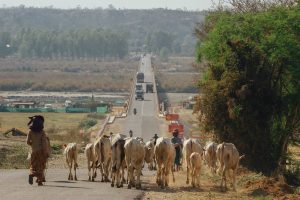After fierce fighting, Myanmar’s military yesterday entered a small town in western Chin State which has been in open rebellion against the country’s military junta since last month.
According to Radio Free Asia, the Myanmar armed forces, or Tatmadaw, pounded the town of Mindat with heavy artillery and helicopter gunships, in an attempt to displace a local ethnic militia that has arisen to resist the February 1 military coup. Home to around 20,000 people, Mindat lies in the mountains of western Myanmar’s Chin state around 100 kilometers from the border with India.
The assault followed days of fighting between combat troops backed by artillery and the Chinland Defense Force (CDF), one of several civilian militias that has sprung up to resist the coup government, armed mainly with homemade hunting guns.
According to a statement by the Chin Human Rights Organization, the local CDF outfit “made a tactical retreat in order to save civilian lives from indiscriminate attacks on the town by junta troops using heavy artillery and helicopter gunship.”
A CDF spokesperson said that the group had retreated into the forest, but “will come back to attack soon.” The spokesperson added, “We only have home-made guns. This was not enough.” The CDF claims that at least five civilians were killed and 10 injured during the military assault.
The CDF formed in March and seized control of Mindat in the last week of April. Armed with homemade hunting rifles, the militia claims to have killed at least 30 soldiers during four days of clashes in Mindat in late April, followed by another eight in the state capital Hakka in early May.
According to The Irrawaddy, the military put Mindat under martial law on May 13, after fighting erupted again between Tatmadaw troops and the CDF, marking the end of a brief ceasefire that the two sides had established in order to facilitate a prisoner exchange.
The assault on Mindat was quickly denounced by rights groups and Western embassies. The U.S. Embassy said in a tweet on Saturday that the military’s “use of weapons of war against civilians, including this week in Mindat, is a further demonstration of the depths the regime will sink to to hold onto power.”
What happens next is unclear, but the Tatmadaw’s usual modus operandi suggests the likelihood of fierce reprisals now that the town is under its control. In an emailed statement yesterday, Phil Robertson of the U.S.-based group Human Rights Watch said that “new fears have come to the fore about possible arbitrary arrests, abuses and torture in custody, retaliation against militants’ families, and other rights abuses long associated with the Tatmadaw operating in the field.”
The fighting in Mindat is a likely harbinger of things to come, as increasing numbers of anti-coup protesters eschew non-violent protests for various degrees of armed resistance to junta rule. At least 796 people have been killed by the junta’s security forces in crackdowns on protests against its rule as of May 16, according to the Assistance Association for Political Prisoners, a local civil society group.
The CDF is just one of a number of civilian militias that have formed in townships across the nation since the February 1 coup, especially in north and central Myanmar.
These groups have been given a further boost earlier this month with the formation of a People’s Defense Force (PDF) to combat the junta. Established by the National Unity Government, a shadow government made up of members of the ousted National League for Democracy government and representatives from ethnic minority groups, the PDF is intended as the nucleus of a new federal army.
As noted by Frontier Myanmar, instances of armed civilian resistance were reported across north and central Myanmar this week. Sagaing Region has served as a hotbed of civilian resistance for some time, with fighting reported in several townships, while junta forces overran a group calling itself the Myingyan People’s Defense Force in Mandalay after days of skirmishes.
These ongoing spot fire clashes between the Tatmadaw and armed civilians suggest that Myanmar’s long-running civil conflicts, once confined to remote parts of the country’s periphery, could soon migrate to the city’s urban centers.

































